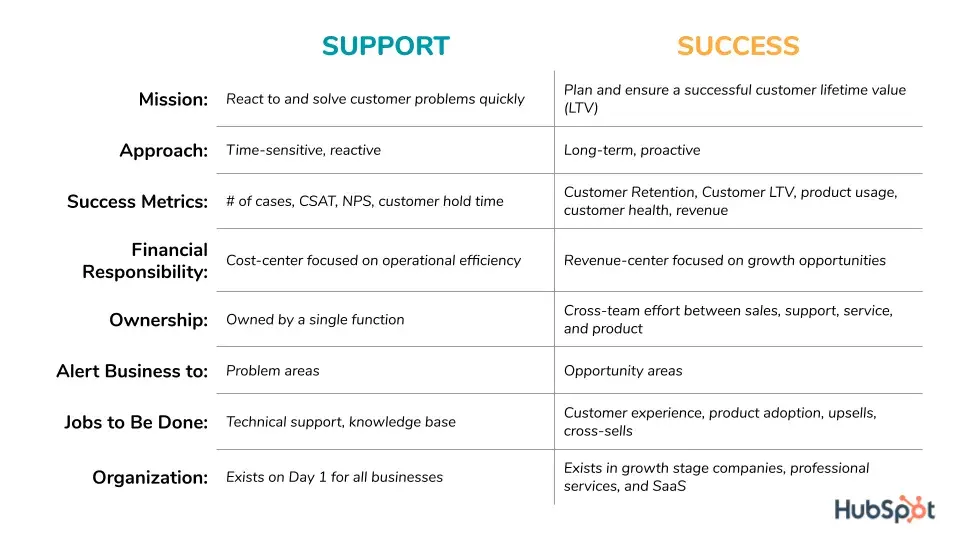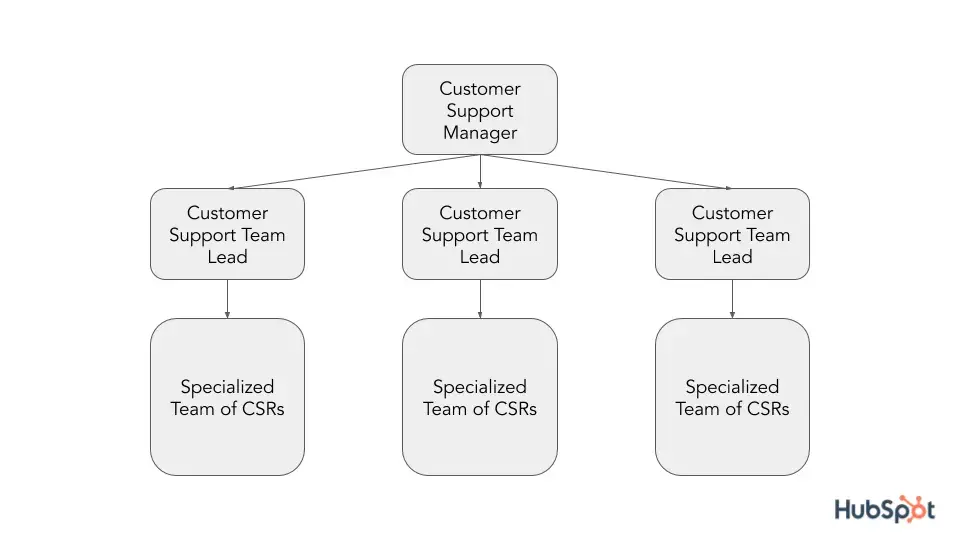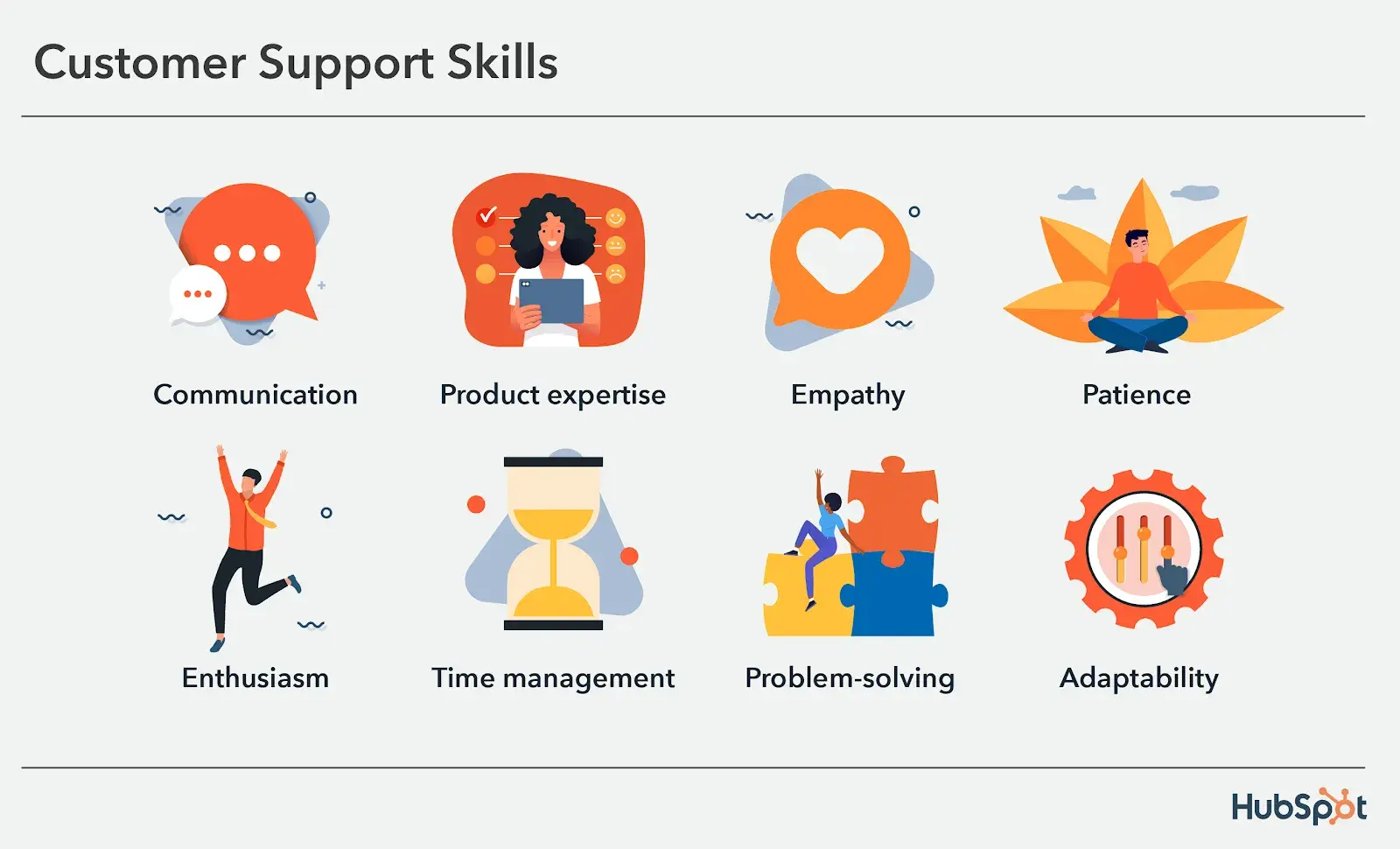In this post, I’ll break down everything you need to know about customer support, why it is vital for your business, and how to develop a killer customer support strategy to meet your business goals. Onward!
What is Customer Support?
Customer support is the process of solving any customer challenges and pain points via phone, email, live chat, tickets, or social media. Customer support ensures a smooth user experience and strengthens the trust and loyalty between a brand and its customers.
Your customer support team is on the front lines of the battle for customer delight. Its responsibility is to help customers with questions, concerns, and issues related to your product or service. However, customer support is more than troubleshooting. It is an integral part of the customer experience that often dictates the customer’s perception of your company.
My favorite moments working in customer support were when I transformed frustrated customers into raving brand advocates. Positive customer support experiences are not only gratifying for the rep but can also drive business growth through loyalty, advocacy, and customer retention.
I can’t stress enough how crucial customer support is for business growth, but you don’t have to take my word for it. Here are some stats that paint the picture of why customer support is so vital:
- 50% of customers will switch to a competitor after one bad experience.
- 75% of customers are willing to spend more to buy from companies that give them a good customer experience.
- If the company’s customer service is excellent, 78% of consumers will do business with a company again after a mistake.
- 93% of customers will likely make repeat purchases with companies that offer excellent customer service.
How Customer Support Interacts With Customer Service and Customer Success
Customer support, customer service, and success are all customer-facing teams critical to your business’s prosperity and growth. However, they aren’t all the same.
Here’s a quick breakdown of their definitions and differences.
Customer Service vs. Customer Support
Customer service teams take a proactive approach to customer delight. They focus on anticipating customer needs and addressing them before they arise. For example, customer service at a SaaS company may contact customers regarding product updates and new features to help them meet their goals.
Conversely, customer support teams are reactive, meaning they respond directly to customers when they contact them with questions, comments, and concerns. When I was a support rep at HubSpot, I never called customers out of the blue to check in or provide updates because that wasn’t the role of a support rep. Instead, I received incoming phone calls and email support tickets and responded reactively to those customer inquiries.
Integrating customer support and success provides a holistic support ecosystem for customers that addresses their immediate and anticipatory needs. Doing so creates a customer-centric environment that fosters retention and long-term customer loyalty.
Customer Success vs. Customer Support
Customer success teams take a high-level strategic approach to helping customers identify goals and achieve success using their company’s product/service. As opposed to customer support's reactive, troubleshooting-oriented approach, customer success works in a consultative capacity with customers to ensure long-term success and lifetime value.
Customer success teams are also likely to collaborate with other departments, like Sales and Product, to upsell and cross-sell customers on new features and products that help them meet their business goals.
Additionally, customers are likely to have a single dedicated customer success manager who is their primary point of contact for consultation and strategy. Meanwhile, there is typically no dedicated customer support rep. When a customer calls in for help, they will receive support from whichever support team member is available to field their inquiry.

Customer Support Team Structure
Let’s talk about building your dream team. The structure of your customer support team is vital to its effectiveness as it will inform the following:
- The agility and knowledge of your team
- Quality of support and customer satisfaction
- The team’s ability to scale with company growth
To establish or refine your team's structure, you must start by evaluating your and the customer’s needs. Consider the type of support customers most often seek. Are they looking for support with technical issues, onboarding, refunds, or perhaps returns? Answers to this question vary by industry, so tailor your team’s structure accordingly.
The image below shows a standard customer support team structure that you can follow:

As a support rep at HubSpot, we exclusively handled technical questions, and our team was structured accordingly. I started as a regular frontline support rep but eventually moved up to Team Lead, where I advised and onboarded a small group of more junior reps.
Since we specifically dealt with technical questions regarding our SaaS product, our team structure also included Product Experts. Product Experts were highly experienced support reps with specialized knowledge in specific areas of the product, and their job was to handle and assist with difficult and escalated cases.
Ultimately, your team's structure should align with customer needs so your reps are always equipped to handle the cases that most commonly enter the queue.
Customer Support Responsibilities
The responsibilities of each customer support team will be unique to their industry and customer needs. However, here are some common day-to-day tasks for a customer support rep:
- Answer customer phone calls. When a customer calls in with a question or issue, support reps are there to pick up the phone and help.
- Reply to customer emails. Support reps also respond to customer inquiries via email.
- Operate live chat. Some customers want immediate support, and reps are there to help by handling real time conversations via live chat.
- Provide social media support. When customers post questions and concerns on social media channels, support reps are there to help out on X, Facebook, Instagram, or wherever else your customers hang out online.
- Create and update knowledge base content. Specialized support team members are responsible for maintaining, writing, publishing, and updating the self-help content that helps customers answer questions independently.
- Assist with customer onboarding and training. Support reps will help new customers become familiar with their products and services.
- Train new reps. Experienced support team members will help onboard and train new reps by shadowing phone calls and conducting training.
- Handle customer feedback. When customers submit complaints, praise, or suggestions, support reps respond thoughtfully and escalate when necessary.
- Collaborate with other departments. As the primary customer-facing team, customer support will collaborate with other departments, like engineering and product, to resolve complex issues and communicate customer needs.
- Maintain a positive, on-brand presence. As the face of your company to many customers, support is responsible for embodying brand values and delivering positive interactions to customers at every touch point.
Customer Support Channels
Given today’s customer-centric landscape, offering omni-channel support is non-negotiable. Customers expect you to meet them where they are, not the other way around. Here are all the support channels you should provide:
- Phone. A dedicated phone support line is fundamental. Customers should be able to call your support team and speak with a representative to receive the support they need.
- Email. Ensure your customer support team has a universal email inbox where customers can send inquiries and questions and expect thoughtful, written responses.
- Live Chat. Live chat functionality on your website allows customers to receive support in real-time and resolve issues quickly.
- Social Media. Monitor and provide support on social channels like X, Facebook, Instagram, Whatsapp, or wherever else your customers are. You can use social media software to monitor brand mentions and manage replies in a universal inbox.
- Knowledge Base and FAQ. Customers expect self-help content so they can answer questions independently. Ensure reps regularly update and maintain these valuable resources.
- Community. Foster a customer-led community where users can discuss and exchange knowledge and experiences using your product. Your support team should moderate and review threads to provide further support and identify recurring issues.
- Tickets. Customers should be able to submit support tickets through your website. Use ticketing software to manage and automate assigning these requests to reps.
For instance, HubSpot's Support Page outlines all the support channels we offer customers, making obtaining and providing support as simple as possible.
Next, let’s review some skills needed to ensure customer support success.
Customer Support Skills
Customer support reps need various skills to succeed and deliver customer satisfaction. Here’s a quick rundown of essential customer support skills to help you connect with customers and deliver top-quality support.

Communication
Effective communication is the cornerstone of high-quality customer support.
I’m an introvert, so when I started in support, I was worried I would struggle to communicate with customers. However, having communication skills doesn’t mean you need to be the life of the party. Instead, I found successful communication meant articulating myself clearly and concisely to support customer concerns.
Pro tip: Listen with the intent to understand, not to respond. Then, re-articulate to the customer what they are trying to accomplish to ensure you and them are both working towards the same goal.
Product Expertise
There is simply no substitute for expertise in the product you support. To effectively respond to customers' inquiries, you need to know what you’re talking about. A comprehensive understanding of all your product’s features and capabilities allows you to answer questions and provide valuable insights that enhance the customer experience.
Pro tip: Be honest. It’s impossible to know everything. If I encountered a question I was unsure about, I would let the customer know I would do some research and testing to ensure I could provide the best possible answer.
Empathy
Empathy is crucial in customer support. Reps must understand customers' needs, actively listen, and show genuine compassion and desire to solve their problems. To provide the best quality customer support, reps must have an intimate understanding of how the customer feels and what they need from your company’s product or service.
Pro tip: Empathy is most critical in difficult situations when customers are frustrated or upset. In those cases, I think you should always start by validating how the customer feels. Showing you understand why they are upset makes it clear that you are there to help.
Mental Toughness and Patience
Take it from me: customer support isn’t always a walk in the park. When I worked at HubSpot, there were tough days when the phone lines were overloaded, and it felt like we were drowning in tickets.
It takes mental toughness and patience to remain calm when facing situations like this, and even more so when unfairly confronted by demanding or rude customers.
Pro tip: Resilience is like a muscle. It will build over time as you become more experienced and confident in your work. Take breaks, remember to breathe, and don’t be afraid to lean on your teammates when you need help. Even support reps need support sometimes.
Enthusiasm
As members of a company's primary customer-facing team, customer support reps must display a positive and enthusiastic attitude that embodies brand values. Show customers you are motivated to help solve their problems and make them feel good about working with your brand.
Pro tip: Authenticity is key. You want to have a positive attitude, but don’t overdo it. In my experience, customers can tell if you aren’t being genuine.
Time Management
Time management is an essential skill for staying on top of piles of customer requests. As a support rep, you’ll need to learn to work quickly and prioritize customer requests to resolve the most urgent matters first. I’ve found that the most successful reps have a sense of urgency that drives them to solve issues quickly yet thoroughly.
Pro tip: Try the Pomodoro Technique, which involves segments of highly focused work broken by short breaks to manage time.
Problem-Solving
Problem-solving is at the heart of what we do as support reps. Customer inquiries aren’t always straightforward, so you must develop strong problem-solving skills to understand what's being asked and provide solutions.
Pro tip: Sometimes, there isn’t a simple solution to a customer’s question. In such cases, support reps can use their resourcefulness, creativity, and analytical skills to devise workarounds that accomplish the customer’s goal in unexpected ways.
Adaptability
Customer support reps must adapt to ever-changing business strategies and product offerings. As your products and services evolve, so must your support reps' knowledge and expertise.
HubSpot’s product is constantly evolving and improving, so when I worked at HubSpot support, I had to stay on top of updates and new features to provide the highest-quality support.
Pro tip: Adaptability is a mindset. To stay effective in your role, avoid getting set in one particular way of doing things and get excited about new features and offerings.
Next, I’ll discuss high-level strategies for improving the overall quality of your support.
How to Improve Your Customer Support Strategy
I found working in support to be highly rewarding. Knowing I was positively impacting my customers and the company’s bottom line felt great. However, working in customer support isn’t without its challenges.
It can be mentally taxing and, at times, discouraging to face an overwhelming onslaught of tickets and hurtful words from upset customers. That said, it’s crucial to set reps up for success with customer support strategies to help them remain motivated, effective, and engaged.
1. Optimize staffing and training.
No matter how bright and motivated your support reps are, they can’t succeed without proper staffing and training. When hiring a team, you should first consider how many reps you’ll need. Analyze your current and expected volume of incoming customer inquiries to determine the amount of reps you’ll need to provide the highest quality support per your SLAs.
Training needs will vary greatly depending on your industry. Software companies like HubSpot will require greater training to bring reps up to speed with feature-rich products. I underwent a vigorous training program during my first few weeks at HubSpot, which was necessary considering the depth of the product I supported. However, retail companies, for example, may require less training if reps' primary responsibilities are processing refunds and updating orders.
2. Identify key skills for development.
The fundamental skills I mentioned above are essential for all customer support reps. However, you should decide which specific skills are most necessary for your customer support strategy and business goals.
When I worked at HubSpot, a significant emphasis was placed on empathy and problem-solving skills in support reps, which aligned with our values.
Analyze customer interactions to determine which fundamental skills are necessary for meeting customer needs. For example, Trader Joe’s clearly values a friendly, outgoing, and borderline flirtatious attitude among its cashiers. Meanwhile, a technology company like Microsoft likely values analytical and problem-solving qualities over conviviality.
3. Foster collaboration with product teams.
Position your customer support team near your product team in the office. Physical proximity enhances collaboration and teamwork in service of customer needs, especially if you run a software company where support and product need to work closely to identify and solve issues.
4. Equip reps with the right tools.
Ensure that your customer support reps have the right tools for the job. That likely means you’ll need customer support ticketing software to organize incoming tickets into a shared inbox and communicate with customers across all support channels. There are many tools to choose from, and the right tool for your customer support strategy is highly dependent on your and your customer’s needs. So, check out as many tools as possible to find the one that fits your needs.
Pro tip: Don’t skimp on training your reps to use your customer service software. To succeed in supporting customers, your reps must navigate your ticketing system like the backs of their hands.
5. Empower and motivate your team.
To provide customer satisfaction at the highest level, your support team must be satisfied themselves. Showing your team how much you value their hard work and commitment will bolster team morale and strengthen their desire to provide the best support possible.
When I worked in support, HubSpot went to great lengths to ensure the satisfaction of the support team and all employees. I loved the free coffee and unlimited vacation time, but what really made me feel valued was that management took our feedback and recommendations seriously. Feeling recognized and heard was a boon for fostering my sense of ownership and motivation to solve problems for the customer.
6. Measure and analyze team performance.
Regularly analyzing your support team’s results is essential for optimizing your customer support strategy. Use metrics such as Net Promoter Score (NPS), Customer Satisfaction Score (CSAT), Customer Effort Score (CES), and general feedback to understand how your team is doing and uncover areas for improvement.
Combine this data with internal employee satisfaction metrics for a holistic view of your team’s health.
7. Promote self-care and well-being.
Burnout is an unfortunate reality of customer-facing roles, but you can prevent it by creating systems and support networks that empower your team. Here are a few strategies to keep your reps happy and healthy:
- Encourage extracurricular activities. Allow time for your reps to explore personal projects, skill development, and networking opportunities. Customer support is often an entry-level job for most reps, so allow reps the chance to grow and develop skills that will benefit their careers and make them even more of an asset to your company.
- Invest in education. Provide support reps with opportunities for training and education that enhance their current skills and facilitate their eventual transition to other areas within the company.
- Provide mental health resources. Access to mental health resources like counseling services, stress management programs, or mindfulness workshops will significantly improve well-being.
- Give access to relaxation spaces. Provide designated relaxation areas where your reps can unwind during breaks. As a support rep, I spent a lot of time in HubSpot’s meditation rooms, and I think every company should offer one!
- Offer recognition and rewards. It’s remarkable how motivating it is to be recognized for your hard work. I still remember how good it felt to be awarded for being a top-performing rep for one month. Celebrating your reps' achievements will boost morale and motivation.
- Create feedback channels. Provide reps with a way to submit feedback about their work environment and well-being. At HubSpot Support, we had an anonymous feedback channel so reps could comfortably share their thoughts with our customer support management team.
Customer Support Software
Customer support software is essential for managing customer interactions, streamlining processes, and enhancing your team's productivity. As a support rep, I spent my entire day inside customer support software, so I can’t stress enough how important it is for your tools to be user-friendly and include all the necessary features to solve for the customer.

HubSpot Service Hub is a customer-centric, full-service software solution that can empower every aspect of your support operation.
Below, I’ll review a list of additional high-quality support tools you can consider for your team.
Ticketing Software
Help desk and ticketing software is critical for organizing incoming customer requests. It allows you to track, triage, and automatically assign cases to the right person, ensuring no request goes unnoticed.
Surveys
Surveys are critical to measuring your business’s internal and external successes. Whether you’re obtaining customer feedback before or after working with a rep or asking your CSRs about their satisfaction and happiness working for your company, Survey and Customer Feedback software can tell you important information about the people who matter most to your success and growth.
Knowledge Base
Managing a knowledge base for your customers is an important part of empowering them.
Knowledge base software will help you create a hub of educational support content so customers can help themselves and answer questions independently. Your knowledge base may include FAQs and other instructional information. Not only does a knowledge base empower customers, but it saves your reps time.
Universal Inbox
HubSpot, Zendesk, and Freshdesk offer shared inboxes to help customer support reps organize incoming tickets from all support channels into a unified inbox. A universal inbox also keeps track of each customer’s interaction history, giving reps the context to provide personalized and informed support.
In my opinion, the user interface of your universal inbox is critical. That’s where your reps spend all their time, so handling tickets should be intuitive. I love sleek, minimal UI that does make me feel overwhelmed when tackling mounds of tickets.
Live Chat Software
Customers expect immediate support via live chat software in today's support landscape. Live chat enables real-time customer interactions via a widget installed on your website. It provides another option to enhance customer satisfaction and increase efficiency, as reps can handle multiple conversations at once and resolve cases swiftly.
I love live chat. As a customer, I prefer to use live chat whenever possible because it's quick and easy, and I don’t have to pick up the phone!
Social Media Software
Customers are bound to take to social media to provide feedback, ask questions, or lodge complaints about your brand. Social media software allows you to monitor and manage customer interactions across all social channels in a unified inbox.
I was a member of the social support team during my time at HubSpot, where we used social listening to monitor for brand mentions and even specific keywords. With this information, I could proactively support customers online, bolstering overall satisfaction.
Customer Support and Business Growth
I believe customer support is a massive and underrated driver of business growth. It is the direct connection between your customers and your business, and it has the potential to drive revenue in multiple ways.
Enhances Customer Retention
Excellent customer support encourages customers to stick around. I speak from experience when I say customers who receive empathetic, timely, and high-quality support will likely remain loyal to your brand.
What I find interesting, and what many people don’t recognize, is that retaining existing customers is just as important, if not more important, than gaining new ones. To be exact, acquiring a new customer costs 5x as much as retaining an existing one. Furthermore, repeat customers spend 67% more than new customers.
My point is that focusing on customer retention is a clear path to business growth. The best way to do that is by investing in your support team so your customers can have high-quality experiences at every touch point. 93% of customers are likely to stay loyal to a brand that offers excellent customer service. Furthermore, a 5% improvement in customer retention could increase profitability by 25%.
So, join the loyal customer club and experience long-term growth through high-quality customer support and retention.
Encourages Word-of-Mouth Marketing
Word-of-mouth marketing is a powerful tool for business growth. One way to drive it is by offering an excellent product (which I know you do), but another is by delighting customers. 92% of consumers trust recommendations from friends and family over all other forms of advertising, making it a critical factor in driving purchases and business growth. This is true for me, as I always scour reviews and ask my friends for recs before buying anything.
However, we’re talking about customer support, not just reviews. Research shows that 72% of customers will share a positive customer experience with six or more people. That’s a lot! Think about the exponential word-of-mouth power your support team wields.
By providing high-quality customer support, you generate an ever-growing network of brand advocates who will tell others about their good experiences, enhance your reputation, and drive growth.
Reduces Churn Rates
Effective customer support ensures your customers' issues are resolved quickly, reducing frustration and the likelihood of them leaving you for competitors.
67% of churn is preventable if the customer’s problem is solved during their first interaction with support. Reducing churn rates through optimal support interactions saves your business significant amounts of money in customer acquisition costs and retained revenue. Do you know what that means? Growth!
Pro tip: Handling customer issues quickly is a large part of preventing churn, so consider investing in an all-in-one customer support solution that ensures reps have all the necessary tools to tackle tickets efficiently.
Premium Prices for Premium Service
Customers want to feel good about buying from your company, and the best way to do that is through premium customer support. Over 80% of customers reported that an excellent support experience makes them more likely to repurchase from a given brand, even when presented with the opportunity to switch to a competitor.
In addition, 86% of customers are willing to pay more for a better customer experience. So, I think investing heavily in your customer support team is vital to creating positive experiences that keep customers coming back willing to pay a little extra.
Pro tip: If you charge higher prices, your level of support must genuinely reflect that. If it doesn’t, customers will catch on quickly. Always solve for the customer, resolve issues quickly, and ensure that your reps go above and beyond to make customers feel delighted about working with your brand.
Helps Gather Valuable Feedback
Customer support interactions provide valuable customer feedback and insights into the customer journey that can’t be gathered elsewhere.
As a frontline rep, I had a unique first-hand perspective on our customers’ needs, challenges, and how they used our products to succeed. By gathering and analyzing this feedback, you can foster business growth by identifying areas for improvement and making data-driven decisions that align with customer needs and pain points.
Pro tip: Gather and analyze customer feedback following support interactions using customer feedback software.
Increases Customer Lifetime Value
Customer lifetime value (CLV) is a metric that represents the total revenue you can expect from a single customer over their entire lifetime with your business. Increasing this number means increasing the amount they purchase and the longevity of the customer relationship. Effective customer support bolsters both of these things.
If customers have a great experience with your support team, they are much more likely to stay longer and spend more money.
Pro tip: Long-lasting customer relationships are the key to CLV, and those are based on trust. Build trust through consistently excellent support interactions, personalized service, and effective feedback systems.
Delight Your Customers With Great Customer Support
Customer support is more than just a reactive service to customer problems. It is a strategic component of your business's growth. Investing in high-quality customer support will pay dividends in the form of enhanced retention and reduced churn, and customers who are happy to spend their money with you tell others about it.
Embracing customer support as a growth driver means building stronger, long-lasting customer relationships that support positive customer sentiment and sustained growth.
Net Promoter, Net Promoter System, Net Promoter Score, NPS, and the NPS-related emoticons are registered trademarks of Bain Company, Inc., Fred Reichheld, and Satmetrix Systems, Inc.
Editor's note: This post was originally published in May 2019 and has been updated for comprehensiveness.
-3.png?width=112&height=112&name=support%20strategy%20cover%20(3)-3.png)

.png)









